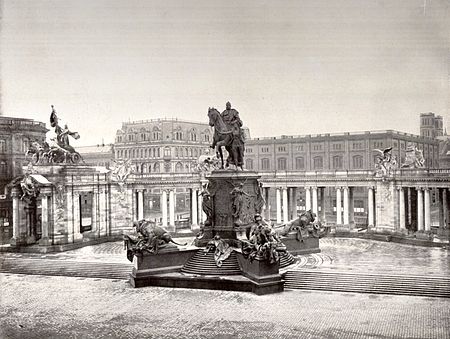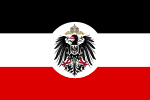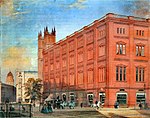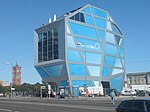The German Empire or the Imperial State of Germany, also referred to as Imperial Germany, the Kaiserreich, as well as simply Germany, was the period of the German Reich from the unification of Germany in 1871 until the November Revolution in 1918, when the German Reich changed its form of government from a monarchy to a republic.It was founded on 18 January 1871 when the south German states, except for Austria, joined the North German Confederation and the new constitution came into force on April 16, changing the name of the federal state to the German Empire and introducing the title of German Emperor for Wilhelm I, King of Prussia from the House of Hohenzollern. Berlin remained its capital, and Otto von Bismarck, Minister President of Prussia, became Chancellor, the head of government. As these events occurred, the Prussian-led North German Confederation and its southern German allies were still engaged in the Franco-Prussian War.
The German Empire consisted of 26 states, each with their own nobility, four constituent kingdoms, six grand duchies, five duchies (six before 1876), seven principalities, three free Hanseatic cities, and one imperial territory. While Prussia was one of four kingdoms in the realm, it contained about two-thirds of the Empire's population and territory, and Prussian dominance had also been constitutionally established, since the King of Prussia was also the German Emperor (German: Kaiser)
After 1850, the states of Germany had rapidly become industrialized, with particular strengths in coal, iron (and later steel), chemicals, and railways. In 1871, Germany had a population of 41 million people; by 1913, this had increased to 68 million. A heavily rural collection of states in 1815, the now united Germany became predominantly urban. The success of German industrialization manifested itself in two ways since the early 20th century: the German factories were larger and more modern than their British and French counterparts. The dominance of German Empire in natural sciences, especially in physics and chemistry, was such that one-third of all Nobel Prizes went to German inventors and researchers. During its 47 years of existence, the German Empire became the industrial, technological, and scientific giant of Europe, and by 1913, Germany was the largest economy in Continental Europe and the third-largest in the world. Germany also became a great power, it built up the longest railway network of Europe, the world's strongest army, and a fast-growing industrial base. Starting very small in 1871, in a decade, the navy became second only to Britain's Royal Navy. After the removal of Otto von Bismarck by Wilhelm II in 1890, the empire embarked on Weltpolitik – a bellicose new course that ultimately contributed to the outbreak of World War I.
From 1871 to 1890, Otto von Bismarck's tenure as the first and to this day longest-serving Chancellor was marked by relative liberalism, but it became more conservative afterward. Broad reforms and the Kulturkampf marked his period in the office. Late in Bismarck's chancellorship and in spite of his earlier personal opposition, Germany became involved in colonialism. Claiming much of the leftover territory that was yet unclaimed in the Scramble for Africa, it managed to build the third-largest colonial empire at the time, after the British and the French ones. As a colonial state, it sometimes clashed with the interests of other European powers, especially the British Empire. During its colonial expansion, the German Empire committed the Herero and Namaqua genocide.In addition, Bismarck's successors were incapable of maintaining their predecessor's complex, shifting, and overlapping alliances which had kept Germany from being diplomatically isolated. This period was marked by various factors influencing the Emperor's decisions, which were often perceived as contradictory or unpredictable by the public. In 1879, the German Empire consolidated the Dual Alliance with Austria-Hungary, followed by the Triple Alliance with Italy in 1882. It also retained strong diplomatic ties to the Ottoman Empire. When the great crisis of 1914 arrived, Italy left the alliance and the Ottoman Empire formally allied with Germany.
In the First World War, German plans to capture Paris quickly in the autumn of 1914 failed, and the war on the Western Front became a stalemate. The Allied naval blockade caused severe shortages of food. However, Imperial Germany had success on the Eastern Front; it occupied a large amount of territory to its east following the Treaty of Brest-Litovsk. The German declaration of unrestricted submarine warfare in early 1917 contributed to bringing the United States into the war. In October 1918, after the failed Spring Offensive, the German armies were in retreat, allies Austria-Hungary and the Ottoman Empire had collapsed, and Bulgaria had surrendered. The empire collapsed in the November 1918 Revolution with the abdications of its monarchs, which left the post-war federal republic to govern a devastated populace. The Treaty of Versailles imposed post-war reparation costs of 132 billion gold marks (around US$269 billion or €240 billion in 2019, or roughly US$32 billion in 1921), as well as limiting the army to 100,000 men and disallowing conscription, armored vehicles, submarines, aircraft, and more than six battleships. The consequential economic devastation, later exacerbated by the Great Depression, as well as humiliation and outrage experienced by the German population are considered leading factors in the rise of Adolf Hitler and Nazism.











